Menus
- The stars of the novelty show
- Honda news
- Yamaha innovations
- Suzuki GSX-R 600
- Kawasaki innovations
- KTM Duke 3
- Changes / dates Honda Fireblade
- Changes / dates Honda Transalp
- Changes / data Honda CBF 600
- Changes / data Yamaha YZF-R6
- Changes / data Yamaha XT 660 Tenere
- Changes / data Yamaha FJR 1300 A / AS
- Changes / data Yamaha FZ1 ABS
- Data Yamaha YZF-R 125
- Changes / data Kawasaki ZZR 1400
- Data Kawasaki Ninja 250 R
- Changes / dates Kawasaki ZX-10R
- Data KTM Duke 3

Manufacturer
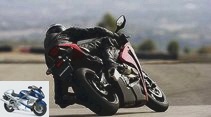
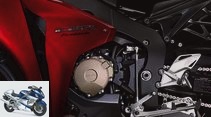
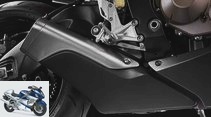
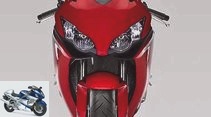
16 photos
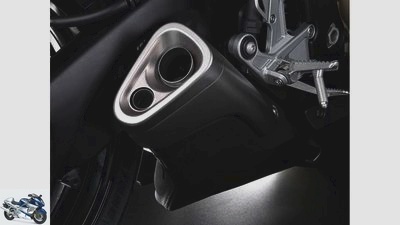
1/16

2/16
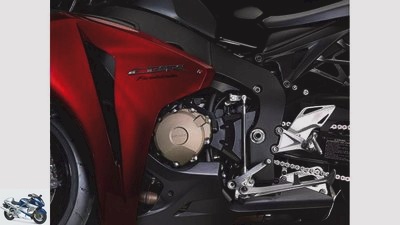
3/16
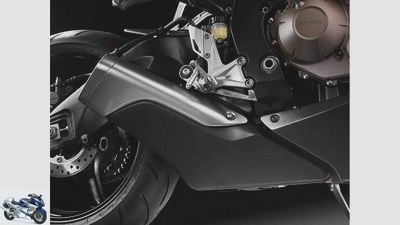
4/16
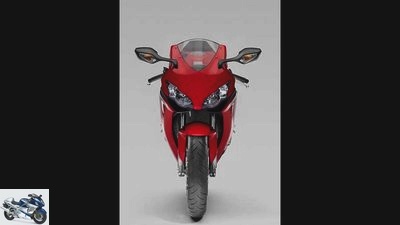
5/16
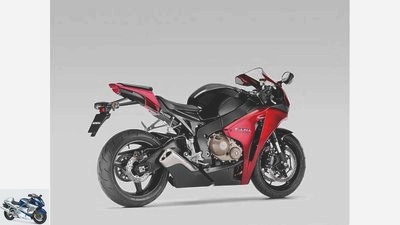
6/16
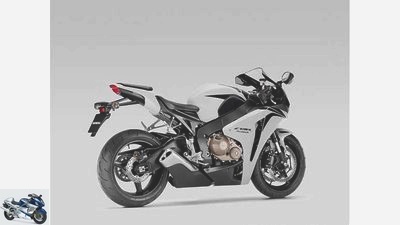
7/16
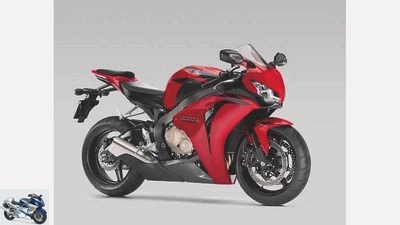
8/16

9/16
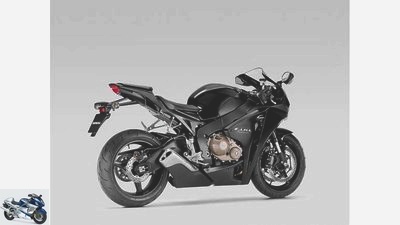
10/16

11/16
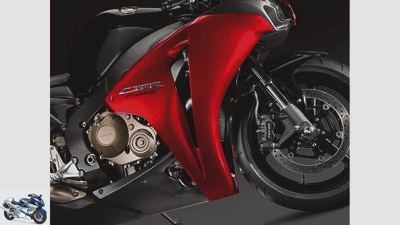
12/16
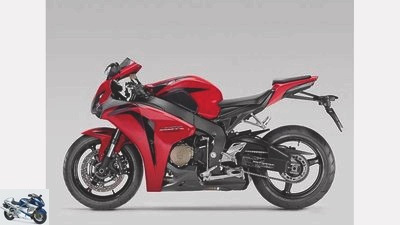
13/16
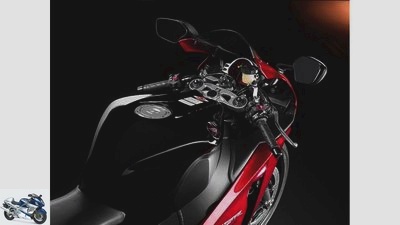
14/16

15/16
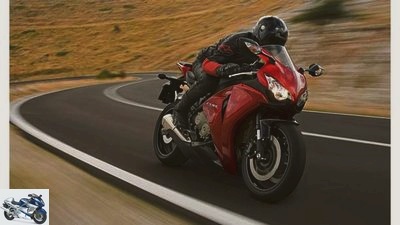
16/16
Honda, Yamaha, Suzuki, Kawasaki and KTM
The stars of the novelty show
At the same time as this issue is published, the first motorcycle fair this autumn will begin in Paris. Not all the new products are known yet, and no one knows who their stars will be. But the new Fireblade is definitely one of them.
With the visit to the imperial city of Kyoto, the experience of Japanese handicraft tradition, which cultivates a meditative care down to the last detail, the developers of the new F.ireblade started work. Says Honda, and it sounds believable. Even if the story wasn’t quite like that, it would be true in a higher sense.
Honda news
Because the motorcycle can give the impression of carefully executed details even in photos. It even seems to surpass the otherwise not exactly sloppy workmanship of all other Honda. Which perhaps also appears so because the details are consistently included in the overall context. When looking at the rear, for example, there is no longer any jumbled small and small, unlike the predecessor, the lines are clearly defined. Where they cross, there is an accent, not a mess.
As one of the most noticeable changes, the “underslung” – looped underneath – called exhaust system of the new Blade has a meaning that goes beyond the obvious “before-above-now-below”. Its design is based on the knowledge that a frame must always be stable enough to support a heavy exhaust system if only the connecting parts are designed accordingly. So why, so the obvious question, should you create a framework for a raised exhaust with a lot of material at the rear, instead of lightening the rear frame and concentrating more mass around the center of gravity? In total, the engineers saved almost four kilograms on the chassis, new wheels contributed 550 grams, and the engine shed another 2.5 kilograms. First of all, by drilling open by one millimeter, which reduces the webs between the cylinders from six to five millimeters and creates an important prerequisite for the output, which has increased by eight to 179 hp. The larger bore provided space for larger inlet valves, which are now made of titanium. The cylinder head was reconfigured and hardly any part was modified for one purpose only. It is always about more power as well as about saving weight or installation space. The new Fireblade does not quite match the weight reduction of the last CBR-600-RR generation, but it is still expanding its position as the lightest four-cylinder. In this respect, the noticeably short front section is not just a different design, but corresponds to what happens inside: concentration.




20th photos
Images: Honda, Yamaha, Suzuki, Kawasaki and KTM
To home page
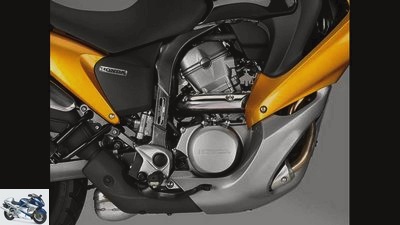
Honda

Honda
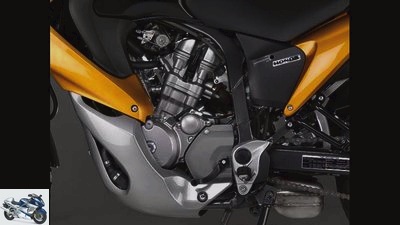
Honda
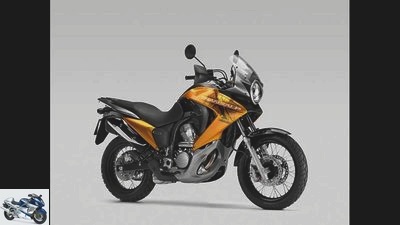
Honda

Honda
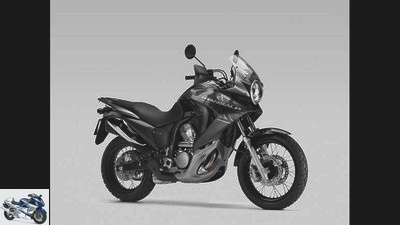
Honda
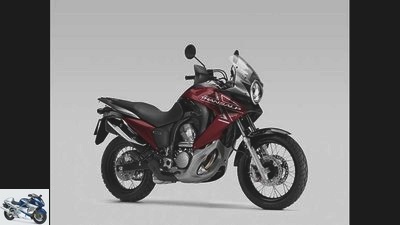
Honda
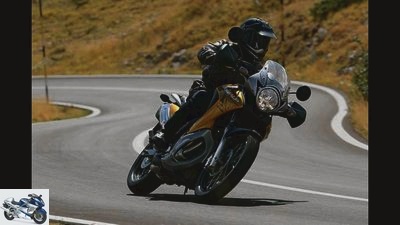
Honda
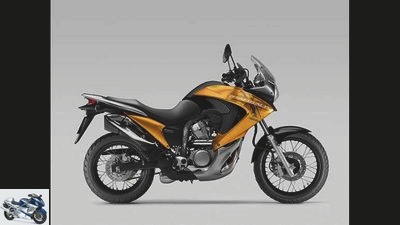
Honda
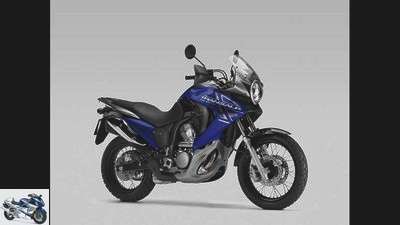
Honda

Honda

Honda
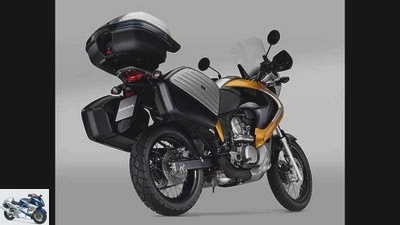
Honda
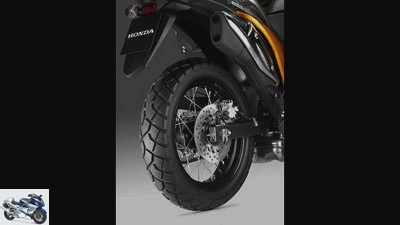
Honda
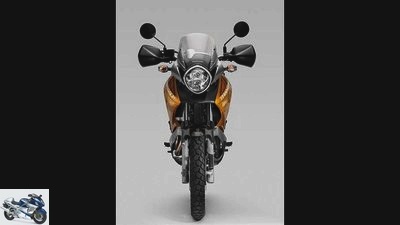
Honda
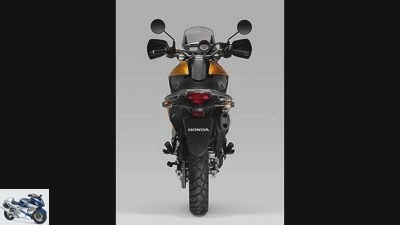
Honda
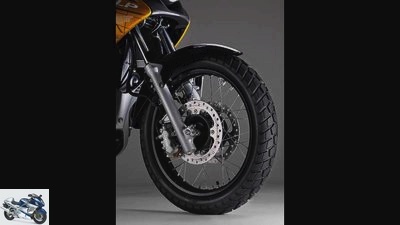
Honda
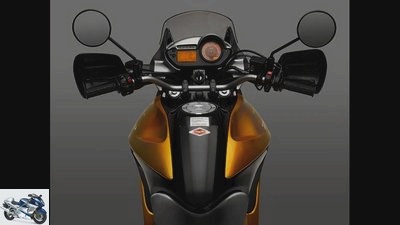
Honda
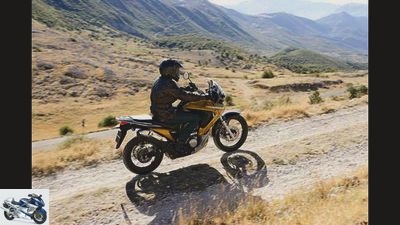
Honda
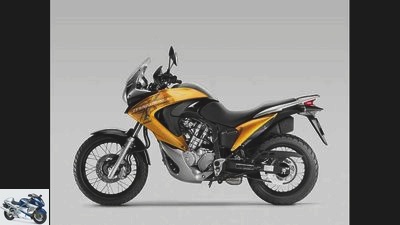
Honda
Yamaha innovations




19th photos
Images: Honda, Yamaha, Suzuki, Kawasaki and KTM
To home page

Yamaha
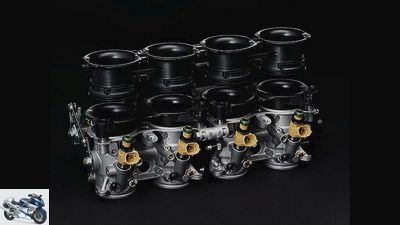
Yamaha
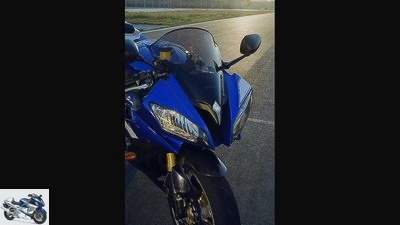
Yamaha
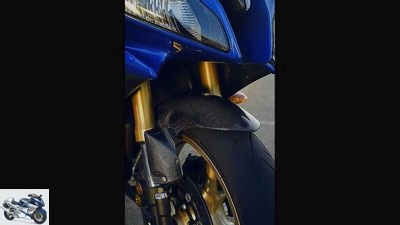
Yamaha
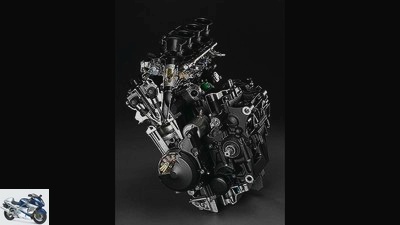
Yamaha
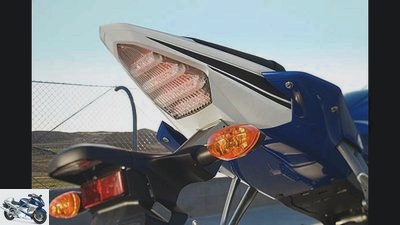
Yamaha
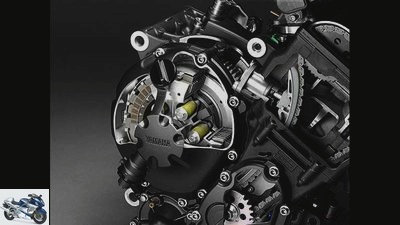
Yamaha

Yamaha
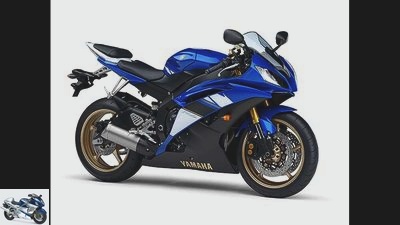
Yamaha
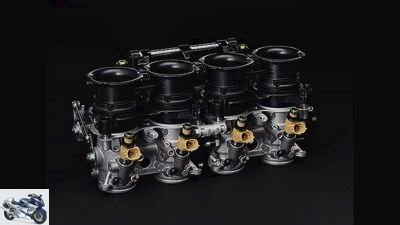
Yamaha
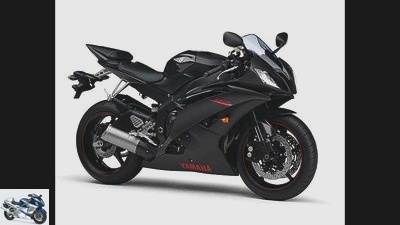
Yamaha
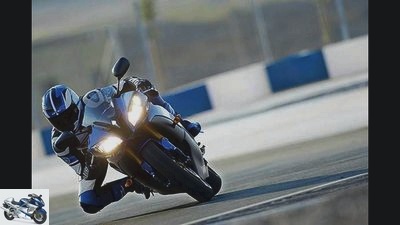
Yamaha
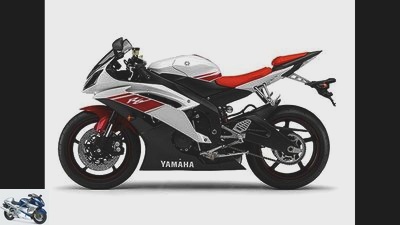
Yamaha
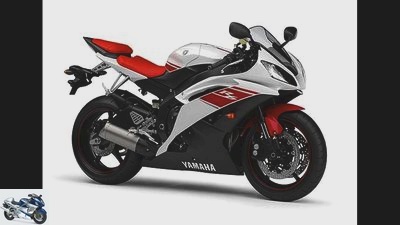
Yamaha

Yamaha

Yamaha
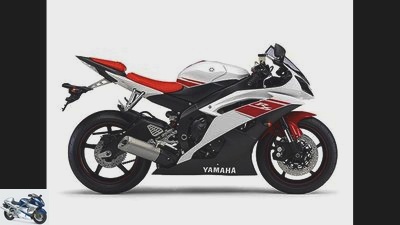
Yamaha
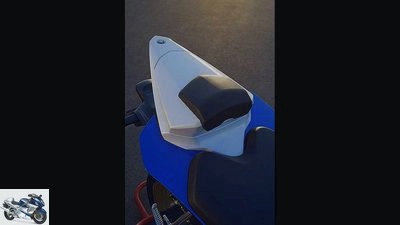
Yamaha
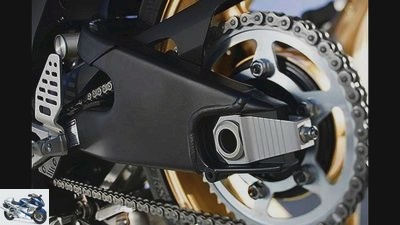
Yamaha
When updating the model of the YZF-R6, Yamaha only gently retouched its external appearance, and that’s a good thing. To give up a design like hers would be to shoot yourself in the knee. On the other hand, the engine technicians were allowed to drive an unprecedented effort for the 600 class. Analogous to the YZF-R1, the R6 got an intake system with variable intake manifold lengths, which should help to make the borderline peak performance a little fuller from below. Depending on the speed, throttle and throttle position, which are not necessarily identical in the drive-by-wire of the R6 (and of course especially when full steam is required), a computer-controlled servomotor lifts the upper half of the intake funnel. Instead of long funnels that increase torque, short funnels are now available to increase performance. In this way, the lead of the R6 in terms of top performance was increased by two hp. 129 hp at 14,500 rpm are a hard to imagine brand. While the variable intake manifolds help to tame such power, new pistons with record-breaking compression, a revised airbox and the larger interference pipe are used to achieve it at all. On the other hand, the widening of the connecting rod bearings, an additional oil hole for the main bearings, new valve springs and a modified timing chain tensioner are more reliable.
The modifications to the chassis are unusual in recent Yamaha history. They reveal a close collaboration with the supersport racing teams. In addition, changes to a cast light alloy frame always mean considerable costs for the mold construction, and the frame rear, which is now cast from magnesium, is certainly not cheap either. Optimized wall thicknesses – less on the upper parts, more in the steering head area – as well as the omission of a cross brace are intended to improve driving behavior, especially when accelerating hard in an inclined position. The swing arm has been redesigned in a similar manner, with additional stiffening ribs in the rear.
Outwardly visible signs of the changes to the fork are the separate adjusters for the compression stage, in addition, Yamaha has widened the triple clamps and changed their offset. The seat and handlebars moved forward by five millimeters, and the handlebars moved down by the same amount. One gets the impression that Yamaha is working with particular meticulousness into an already successful arrangement.




23 photos
Images: Honda, Yamaha, Suzuki, Kawasaki and KTM
To home page

Yamaha

Yamaha
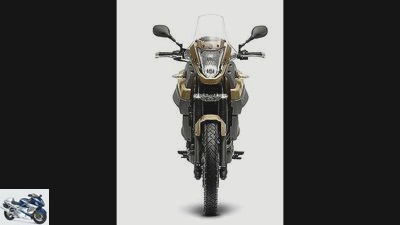
Yamaha
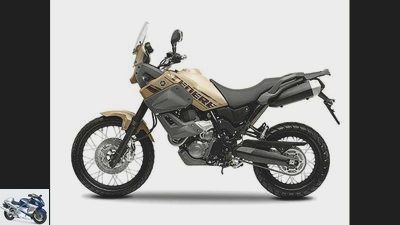
Yamaha
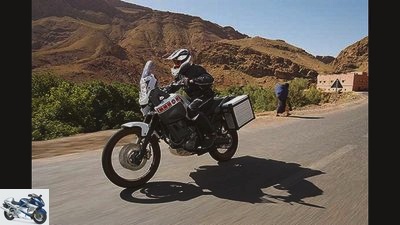
Yamaha
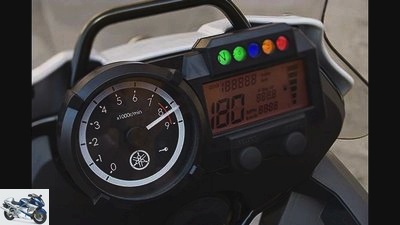
Yamaha
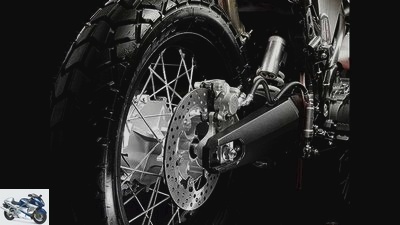
Yamaha
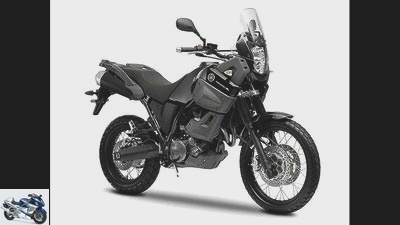
Yamaha
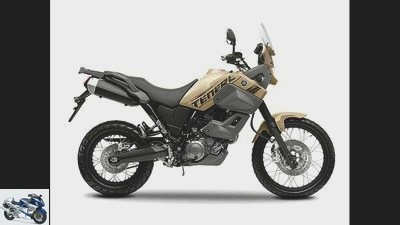
Yamaha

Yamaha

Yamaha
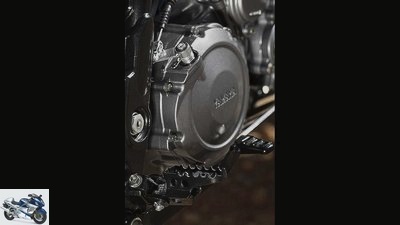
Yamaha
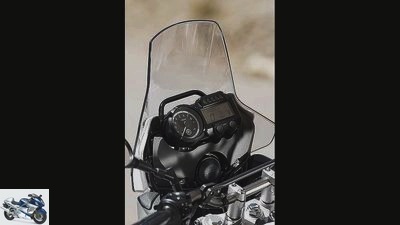
Yamaha
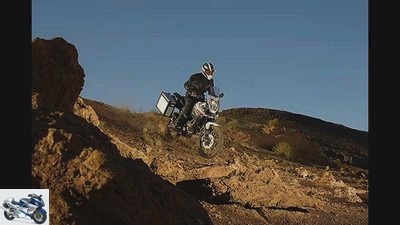
Yamaha
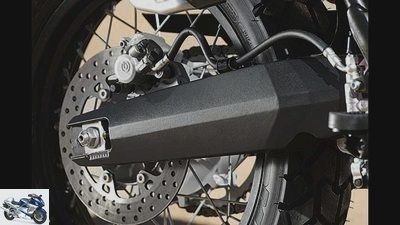
Yamaha
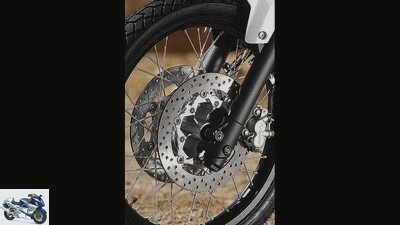
Yamaha
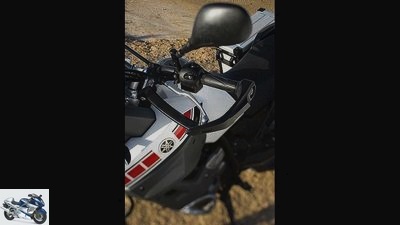
Yamaha
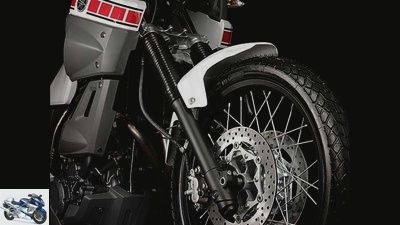
Yamaha
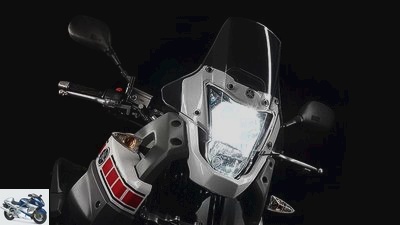
Yamaha
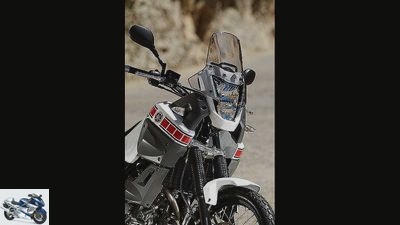
Yamaha
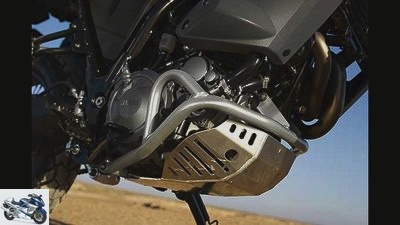
Yamaha

Yamaha
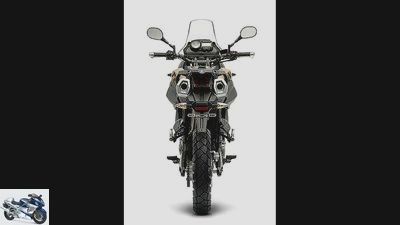
Yamaha
FZ1 with ABS is not yet being used; it receives the system known from the half-faired FZ1 Fazer. The FJR 1300 AS, which is equipped with an automatic clutch and electromagnetically actuated gearshift, was given a different handlebar lever for changing gears.
Like the 660, the new water-cooled four-valve single cylinder of the YZF-R 125 comes from the Italian manufacturer Minarelli, a subsidiary of Yamaha. Already seen just under a year ago at the Milan trade fair, it is now making its debut in a super sports car that has made a very attractive appearance with the design features of the R6. With 15 hp, the single-cylinder can build on the standard set by the MZ singles, the long-stroke design promises a relatively high torque in the middle. The aluminum frame, aluminum swing arm and the 130 rear tire are the external signs of an adequate chassis; they are also a large part of the prestige behavior towards the successful Honda CBR 125 R. Attitudes that are completely alien to the second new 125cc Yamaha. The YBR 125 Custom with its simple air-cooled single-camshaft engine in the cruiser chassis wants to be a cheap, problem-free everyday motorcycle and nothing else.
Suzuki GSX-R 600




11 photos
Images: Honda, Yamaha, Suzuki, Kawasaki and KTM
To home page
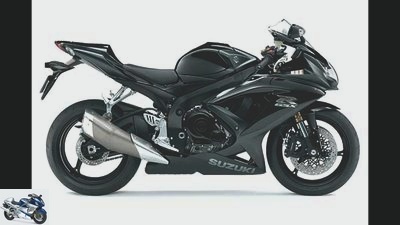
Suzuki
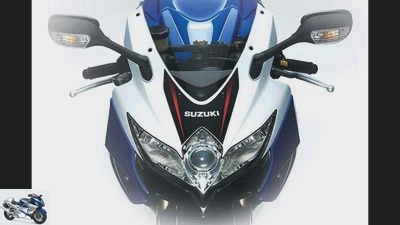
Suzuki
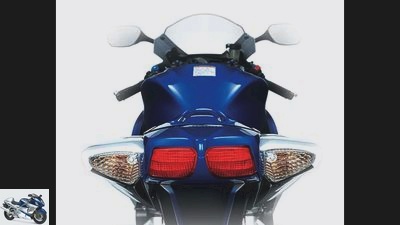
Suzuki
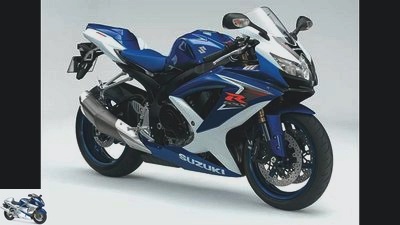
Suzuki
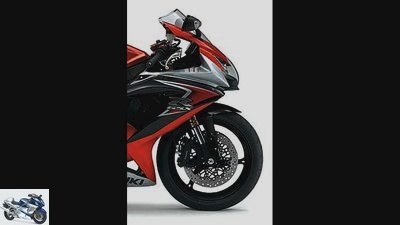
Suzuki
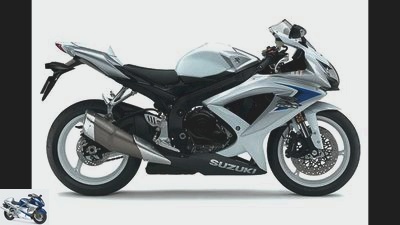
Suzuki

Suzuki
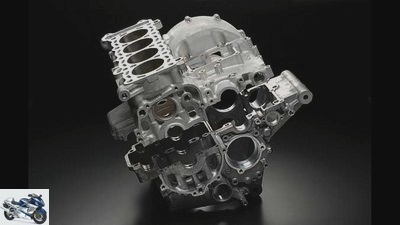
Suzuki

Suzuki
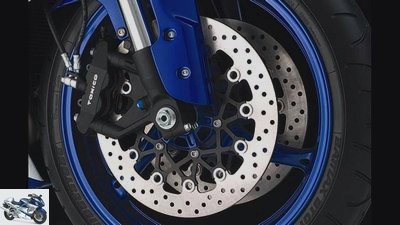
Suzuki
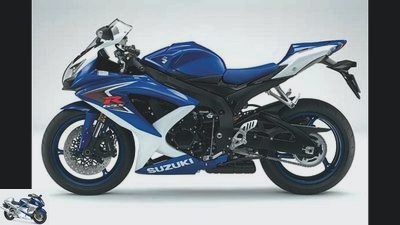
Suzuki
GSX-R 600 to present.
If you compare the driving photo from Germany with the studio photos from the USA, it is noticeable that the cubic capacity designation is missing on the delicate rear panel. The “German” machine could also be a 750 – it makes sense to run high-speed tests with the faster of two types. Because the two models are largely indistinguishable, the continuation of the previous Suzuki policy can be assumed to be certain. It consists of putting two super sports cars on the wheels with many of the same components, which are cheaper in higher numbers, of which the larger-capacity 750 is offered at a higher price than the 600, but on the other hand much cheaper than the 1000. In Germany, many fans take up the offer and drive very well, and with the right skills, quite quickly. The rear silencer, which is visibly larger than the previous models, indicates higher peak performance. Euro 3 has nothing to do with it, the two have met this standard for two years. In particular, the 600 series fell behind and the 750 series would also need a boost in order to achieve the 150 hp that have long been specified. Photo comparisons of course mean that neither the engines nor the chassis are expected to be groundbreaking new designs. Brakes and spring elements have changed, if at all, only in areas that are invisible from the outside.
The designers succeeded in creating a very attractive cladding front. The shape of the spotlight solves the dilemma between horizontal and vertical arrangement with a clever “as well as”. Its large light-emitting surface suggests excellent road illumination, at least in theory.
Kawasaki innovations




12th photos
Images: Honda, Yamaha, Suzuki, Kawasaki and KTM
To home page

Kawasaki

Kawasaki
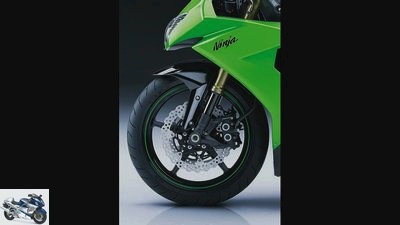
Kawasaki
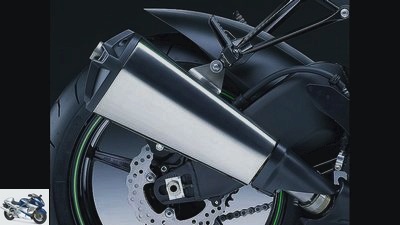
Kawasaki
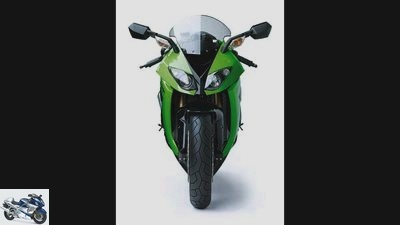
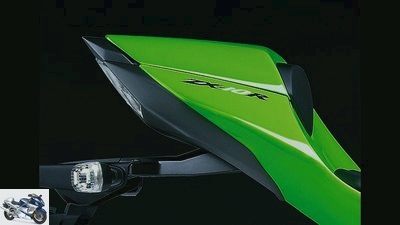
Kawasaki
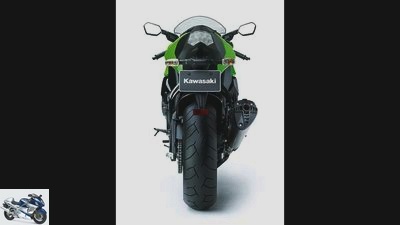

Kawasaki

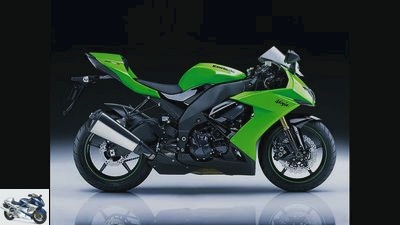
Kawasaki
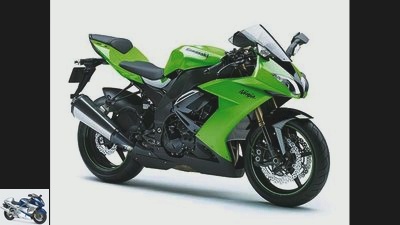
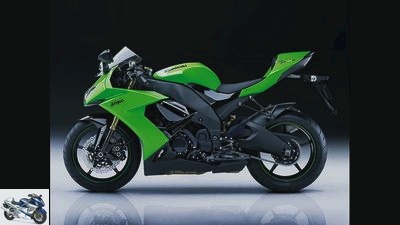
Kawasaki
Kawasaki
An interesting alternative for people with a level driving license: 250 ninja.
If you first looked at the black ninja in the photo on the right for a color variant of the ZX-10R, you were probably mistaken according to the calculations of the product planners. In fact, the picture shows a 250, the Ninja 250 R. A real surprise is this motorcycle, which generates 30 hp from a two-cylinder in-line and thus constitutes an attractive alternative to the hyper-nervous open Aprilia RS 125 or a heavy, clogged 600-cylinder for license holders. Especially since 153 kilograms dry weight could be enough for a fully fueled 170 kilograms ready to drive.
The ZZR 1400 romps on the exact opposite side of the displacement spectrum. In the lower speed range, it has so far shown a torque drop, which was followed by a real explosion of power from 5000 rpm, so the well-intentioned idea of not providing too much power too early required a few engine revolutions turned into its opposite above. In the course of the Euro 3 homologation of the ZZR engine, which became necessary, this peculiarity is said to have been eliminated in favor of homogeneous power delivery. Buyers of the 2008 ZZR will not find it inconvenient that the top performance has increased by three to 193 hp at the same time.
KTM Duke 3
KTM
A recent drastic increase in the number of prototypes caught photographed prompted KTM to send the editorial team a photo of the Duke 3 in its final form just in time for the start of the trade fair. Thanks to the more efficient underfloor exhaust, its 654 single-cylinder produces 65 hp – almost two more than in the Supermoto; allegedly, in interaction with the tightly tuned chassis, it develops such dynamism and intoxicating maneuverability that KTM trusts it to compete against naked bikes like a Honda Hornet or Triumph Street Triple.
Changes / dates Honda Fireblade
technical changes
?? Engine with two millimeters more bore and 33 cm³ more displacement
?? Four instead of three valve cylinder heads
?? Pistons and connecting rods relieved
?? Higher compression
?? Petrol injection, Euro 3 homologation
?? Shorter exhaust
?? Front wheel with a diameter of 19 instead of 21 inches
?? Wheelbase 10 millimeters longer
?? Wider rear tire
?? Optional ABS with single CBS
?? Tank capacity only 17.5 instead of 19 liters
Data
Two-cylinder four-stroke V-engine, bore / stroke 81/66 mm, 680 cm³, 44.1 kW (60 PS) at 7750 / min, 64 Nm at 6000 / min, double loop frame made of tubular steel, double disc brake at the front, Ø 256 mm, rear disc brakes, Ø 240 mm, seat height 841 mm, weight fully fueled with ABS 219 kg
Changes / dates Honda Transalp
technical changes
?? Motor with one millimeter more bore, 1.5 less stroke
?? New forged pistons
?? Redesigned cylinder head, titanium intake valves
?? Exhaust under the engine
?? Anti-hopping clutch with undercut ramps for easier actuation
?? Lighter frame, rocker arm 11 mm longer, arm pivot point higher
?? Shorter trail
?? Lighter wheels
?? Monobloc brake calipers
Data
Four-cylinder four-stroke in-line engine, bore / stroke 76 / 55.1 mm, 1000 cm³, 131 kW (179 PS) at 12000 / min, 114 Nm at 8500 / min, light metal bridge frame, double disc brake at the front, Ø 320 mm, disc brake at the rear, Ø 220 mm, seat height 820 mm, weight with a full tank 199 kg
Changes / data Honda CBF 600
technical changes
?? New engine with injection and Euro 3 homologation
?? Four-in-two-in-one exhaust
?? New aluminum die-cast frame
?? Longer swing arm
?? Adjustable spring preload on the fork
?? Suspension strut adjustable in preload seven times
?? New front brake discs
?? Optional ABS in conjunction with single CBS
?? Immobilizer
Data
Four-cylinder four-stroke in-line engine, bore / stroke 67 / 42.5 mm, 599 cm³, 57 kW (78 hp) at 10500 rpm, 59 Nm at 8250 rpm, light metal backbone frame, double disc brake at the front, Ø 296 mm, rear disc brake, Ø 220 mm, seat height 785 (± 15 mm), weight fully fueled with ABS 223 k
Changes / data Yamaha YZF-R6
technical changes
?? Variable velocity stacks, modified airbox
?? Throttle control reprogrammed
?? Higher compression (13.1 to one) pistons
?? Larger exhaust interference pipe
?? Modified frame and swing arm
?? Fork and shock absorber revised
?? Magnesium rear frame
?? Brake discs 5 instead of 4.5 millimeters thick
?? Changed seat and handlebar position
Data
Four-cylinder four-stroke in-line engine, bore / stroke 67 / 42.5 mm, 600 cm³, 95 kW (129 PS) at 14500 / min, 66 Nm at 11000 / min, light metal bridge frame, double disc brake at the front, Ø 310 mm, Rear disc brake, Ø 210 mm, seat height 850 mm, dry weight 166 kg
Changes / data Yamaha XT 660 Tenere
technical changes
?? Fairing with new headlights
?? Larger (22 liter) tank
?? Double disc brake in front
?? Fork with 15 millimeters less travel
?? Aluminum instead of steel swing arm
Data
Single cylinder four-stroke engine, bore / stroke 100/84 mm, 659 cm³, power and torque k. A., tubular steel frame, double disc brake at the front, Ø 298 mm, disc brake at the rear, Ø 245 mm, seat height 895 mm, dry weight 183 kg
Changes / data Yamaha FJR 1300 A / AS
technical changes
?? ABS with a new pressure modulator, a new control unit and lighter wheel sensors
?? Changed throttle pulley
?? Windshield with scratch-resistant coating and modified attachment
?? Black cover of the instruments
?? AS model only: Hand lever and switch for auxiliary headlights changed
Data
Four-cylinder four-stroke in-line engine, bore / stroke 79 / 66.2 mm, 1298 cm³, 106 kW (144 PS) at 8000 / min, 134 Nm at 7000 / min, light metal bridge frame, double disc brake at the front, Ø 320 mm, disc brake at the rear, Ø 282 mm, seat height 805 mm, weight fully fueled with ABS 290 kg
Changes / data Yamaha FZ1 ABS
technical changes
?? Receives the ABS known from the FZ1 Fazer
?? Lower cladding (according to press release)
Data
Four-cylinder four-stroke in-line engine, bore / stroke 77 / 53.6 mm, 998 cm³, 110 kW (150 PS) at 11000 / min, 106 Nm at 8000 / min, light metal bridge frame, double disc brake at the front, Ø 320 mm, Rear disc brake, Ø 245 mm, seat height 815 mm, dry weight 194 kg
Data Yamaha YZF-R 125
Single-cylinder four-stroke engine, bore / stroke 52 / 58.6 mm, 125 cm³, 11 kW (15 HP) speed and torque not specified, light metal frame, front disc brake, Ø 292 mm, rear disc brake, Ø 230 mm, seat height and weight k. A.
Changes / data Kawasaki ZZR 1400
TECHNICAL CHANGES
?? additional catalytic converter, more efficient secondary air system for Euro 3 homologation
?? Inlet ports revised, new injectors
?? Piston revised to reduce mechanical noise
?? more top performance
?? more torque and more even power delivery
?? newly designed exhaust system
?? lighter rear frame
DATA
Four-cylinder four-stroke in-line engine, bore / stroke 84/61 mm, 1352 cm³, 193 hp at 9500 rpm, torque not specified, light metal monocoque frame, double disc brake at the front, Ø 310 mm, disc brake at the rear, Ø 250 mm, seat height 800 mm, weight dry 224 kg
Data Kawasaki Ninja 250 R
DATA
Two-cylinder four-stroke in-line engine, bore / stroke 62 / 41.2mm, 249 cm³, 22.2 kW (30 PS) at 10500 / min, 21 Nm at 8500 / min, steel bridge frame, front disc brake, Ø 290 mm, rear disc brake, Ø 220 mm, seat height 780 mm, dry weight 152 kg
Changes / dates Kawasaki ZX-10R
TECHNICAL CHANGES
?? Air inlets and exhaust system new
lightened crankshaft
?? Modified oil and water pump
?? oval intake funnels, two injection nozzles per cylinder, oval secondary throttle valves
?? modified inlet ports
?? smaller exhaust valves
?? first, fourth and fifth gear as well as secondary drive have a shorter ratio
?? Control unit with slip regulation
?? Modified tank, seat and rear frame
?? new swing arm
?? lighter wheels
DATA
Four-cylinder four-stroke in-line engine, bore / stroke 76/55 mm, 998 cm³, power and torque not specified, light metal bridge frame, double disc brake at the front, Ø 310 mm, disc brake at the rear, Ø 220 mm, seat height and weight not specified
Data KTM Duke 3
Single-cylinder four-stroke in-line engine, bore / stroke 102/80 mm, 654 cm³, 47.8 kW (65 HP), speed and torque not specified, tubular steel frame, front and rear disc brakes, diameter, seat height and weight not specified
Related articles
-
Jahn comparison test Powercruiser Kawasaki VN 2000, Suzuki Intruder M 1800 R, Yamaha XV 1900 Midnight Star Punchtime Nobody distributes more displacement and …
-
Honda CBF 600, Kawasaki ER-6n, Suzuki Gladius 650 and Yamaha XJ6
Artist Honda CBF 600, Kawasaki ER-6n, Suzuki Gladius 650 and Yamaha XJ6 Comparison test all-rounder Looking for a partner in the world of all-rounders?…
-
Comparison test of supersports: Honda CBR 600 F, Kawasaki ZX-6R, Suzuki GSX-R 600, Yamaha YZF 600 R
Comparison test of super sports cars: Honda CBR 600 F, Kawasaki ZX-6R, Suzuki GSX-R 600, Yamaha YZF 600 R Let’s twist again Wake up, people. In the 600s …
-
Gargolov comparison test travel enduro bikes: Aprilia ETV 1000 Caponord, BMW R 1150 GS, Honda Varadero 1000, Suzuki DL 1000 V-Strom, Triumph Tiger 955i …
-
On the move: Honda VF 1000 R, Kawasaki GP Z 900 R, Suzuki GSX-R 1100
Jahn On the move: Honda VF 1000 R, Kawasaki GP Z 900 R, Suzuki GSX-R 1100 Technical revolution Content of They drove us crazy – and saved us money:…
-
Comparison test: Kawasaki KLX 250 against Yamaha WR 250 R
Comparative test: 250cc Enduro Kawasaki KLX 250 versus Yamaha WR 250 R Not everyone who likes to ride Enduro wants to get through the undergrowth in the fastest time …
-
Comparison test: Honda CX 500-650 Turbo, Kawasaki Z 750 Turbo, Suzuki XN 85, Yamaha XJ 650 Turbo
Jahn 21 pictures Jahn 1/21 The preload of the central spring strut of the Suzuki can be easily adjusted. Jahn 2/21 Tight corners and fast …
-
Comparison test Honda CB 650 F, Yamaha TRX 850, Suzuki SV 650 S and Yamaha MT-07
fact 21 pictures fact 1/21 A huge boost to the parallel twin: the registered flat slide carburetor from Mikuni. fact 2/21 Despite the changed …
-
Artist comparison test middle class Honda Hornet S Kawasaki ZR-7 S Suzuki GSF 600 S Bandit Yamaha FZS 600 Fazer Born to be mild Four days, 1913 …
-
New items for 2009: Yamaha and Honda
Yamaha 28 pictures Honda 1/28 Honda 2/28 Honda 3/28 Honda 4/28 Honda 5/28 Honda 6/28 Honda 7/28 Honda 8/28 Honda 9/28 Honda 10/28 Honda 11/28 Honda 12 / 28 …